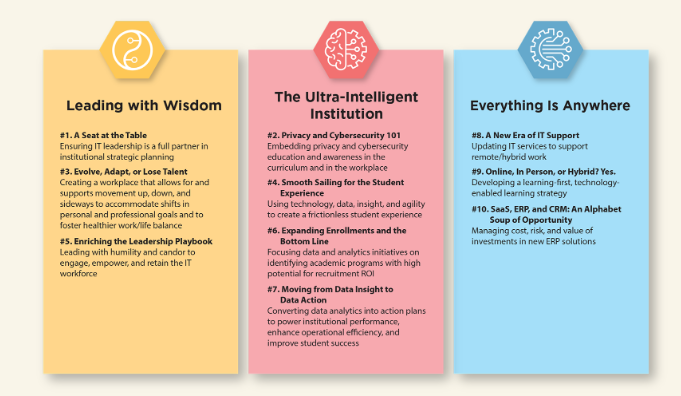How curriculum management addresses the EDUCAUSE Top 10 IT Issues
The EDUCAUSE 2023 Top 10 IT Issues: Foundation Models Report highlights that higher education IT leaders need a seat at the table, and parity with other institutional leaders if institutions are to overcome the challenges ahead.
Some of the major obstacles facing institutions include: building resilient and sustainable digital infrastructure, providing staff with professional opportunities and supporting them through digital transitions, improving student experience and outcomes for improved retention and enrollment, and harnessing technology and data insights, while remaining cyber safe.
The report is also a call to action, entreating IT leaders to seize the opportunity and lead with wisdom.
The EDUCAUSE Top 10 IT Issues of 2023
Every year, EDUCAUSE surveys its members to find the leading IT issues impacting higher education.
This year's Top 10 IT Issues have been grouped into three building blocks to form the basis of what author Susan Grajek metaphorically calls the ‘foundation models’ that institutional and technology leaders are to develop to address their challenges.
The building blocks and top 10 issues are:
 (Source: Top 10 IT Issues 2023: Foundation Models, EDUCAUSE)
(Source: Top 10 IT Issues 2023: Foundation Models, EDUCAUSE)
Many of these issues are resurfacing from the previous years’ issues – cybersecurity, evolve, learning from COVID-19, enrollment, pedagogy and hybrid learning, institutional culture, and digital strategy and transformation. A notable absentee of central focus is technology enabled curriculum, which hasn’t made the list in previous years. This year’s list, albeit still skirting the importance of curriculum, is edging closer to the mark.
The curriculum is at the heart of higher education. It props up every education-related process in academic operations. Given the benefits of curriculum management software, and its potential to help solve some of these top 10 IT issues, it deserves parity with other systems within an institution’s technology ecosystem.
Curriculum management systems are, and will continue to be, an opportunity for technology leaders.
Leading with Wisdom
The Leading with Wisdom building block speaks to the fact that technology is central to our way of life and our future.
Issues:
- #1. A seat at the table
- #3. Evolve, Adapt, or Lose Talent
- #5. Enriching the Leadership Playbook
No longer can institutions regard technology leaders as people to be consulted after the fact if they are to remain competitive today. Technology has a key role and technology leaders, being those best positioned to inform technology-related decisions, unequivocally need a seat at the table.
However, it’s not just institutional strategic thinking that needs to change. IT leaders need to recognize the importance of their role and that they need to “… bridge the middle ground between technology and the institutional missions and business—staff such as business analysts or IT business partners.”
To do this they need humility and candor as they support both their own staff’s career aspirations and their institutional partner’s needs.
In our experience, technology leaders are among those leading curriculum management digitization projects to help relieve administrative burden and leverage innovation, so institutions can remain competitive. Their role is pivotal in the success of these projects in understanding and evaluating, especially, the intuition’s technical requirements of potential solutions.
The Ultra-Intelligent Institution
The Ultra-Intelligent Institution building block signals a shift in thinking and speaks to the importance of managing and using data intelligently.
Issues:
- #2. Privacy and Cybersecurity 101
- #4. Smooth Sailing for the Student Experience
- #6. Expanding Enrollments and the Bottom Line
- #7. Moving from Data Insight to Data Action
It has long been tabooed to speak about enrollments as an essential business requirement. However, enrollment has become an existential problem. Institutions need to be able to respond to changes in demand and get new curriculum to market, quickly.
Student success drives enrollments, and one of the key goals from which to measure student success is employability. Employers are seeking graduates that are able to demonstrate job-readiness and are equipped with the specific skills and knowledge needed to do the job.
This demand is in turn pushing students to seek a curriculum that delivers them employable knowledge and skills. In doing so, they are also looking for assurance of learning and more flexible options for gaining the qualifications. Institutions with the ability to innovate through agile curriculum management are the ones who are going to see a positive impact on enrollments.
Underpinning all of this is the ability to move “from data insights to data action”. Data that drives operational performance and recruitment numbers often gets the most attention here, however, curriculum data can provide particularly advantageous insights to drive positive action.
For example, being able to see and demonstrate the coverage of a program’s curriculum. Data insights can be used to identify gaps in the curriculum as well as evidence the assurance of learning and show the progression of topic mastery, supporting accreditation and re-accreditation activities.
In addition to this, when there is completeness and structure in data capture, and there are APIs available specifically for that data, integration with other systems in the technology ecosystem is seamless. Data integrity and reusability is essential for any institution wanting to advance their data usage.
Everything is Anywhere
The Everything is Anywhere building block really harnesses the lessons learned from the pandemic, as well as speaking to the fact that returning to the way things were is not an option. The world has changed, and higher education with it.
Issues:
- #8. A New Era of IT Support
- #9. Online, In Person, or Hybrid? Yes.
- #10. SaaS, ERP, and CRM: An Alphabet Soup of Opportunity
Students need a frictionless experience. From hybrid learning facilitated by reinventing or leveraging pedagogical approaches such as connectivism, to understanding and engaging students in their chosen education pathway – the curriculum underpins much of the processes that enable this frictionless experience.
Curriculum management SaaS solutions gives institutions the tools to change and refine their curriculum design so they can ensure pedagogy is propped up by comprehensive, quality curriculum, that published catalogs contain accurate curriculum information presented in a clear and user-friendly way, and that staff are relieved of unnecessary administrative burden, so they are encouraged to spend more time on enhancing the student’s experience.
When choosing a SaaS solution, it’s the IT leaders that will be best positioned to evaluate whether a solution covers all the technical bases – integration, cybersecurity, cloud-hosting, business continuity plans etc. Just as IT leaders are central to institutional strategic discussions, they are central to decisions regarding the adoption of SaaS solutions to digitize curriculum management.
Feeling out of the loop? AI foundation models explained.
The author, Susan Grajek, uses the artificial intelligence term ‘foundation models’ metaphorically whereby the Top 10 IT Issues describe the new ‘foundation models’ being developed by higher education leaders to address current issues.
Foundation models is a term used by a group of Stanford researchers to describe large pre-trained, self-supervised artificial intelligence models (e.g. BERT which Google search uses) that form an unfinished base capable of being adapted for a wide range of applications, not just a single task.
Foundation models result in the emergence of new capability and homogenisation of both approaches to modeling and models. Homogenisation is beneficial in that any improvements can be leveraged immediately everywhere. However, it demands caution because any system flaws or biases are inherited throughout. The researchers explain that they chose to use a new term (foundation model) because other terms were too narrow in scope and didn’t adequately describe the paradigm shift signaled by the advancement of these models in terms of capability as well as their societal impact.
Through the metaphorical application of foundation models to higher education, Grajek cleverly highlights the dramatic paradigm shift and resultant advancements in thinking regarding institutional operations, employee satisfaction, and student success – all of which have been born from or accelerated by the pandemic.
The lessons learned and Top 10 IT Issues in combination with highly collaborative, future focused and human-centric strategic input are the building blocks used to develop foundation models specific to higher education with technology and technology leaders playing a central role in our collective future.
Grajek’s juxtaposition of technology’s potential with future uncertainty – reinforces the need for caution while acknowledging the fact that institutions must act if they are to thrive.

